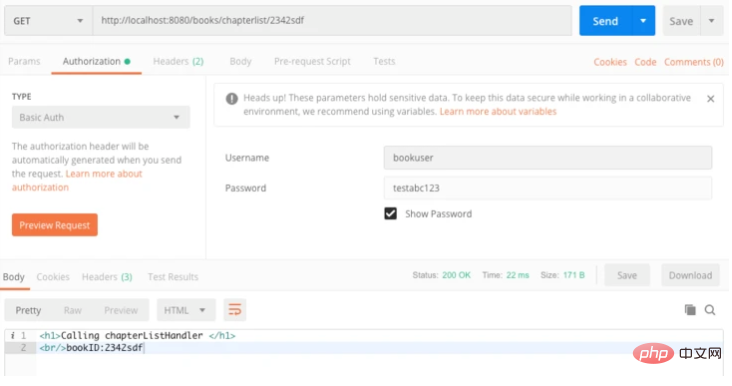##Install iris<span style="font-size: 14px;">go get github.com/kataras/iris<br></span>
Copy after login
<span style="font-size: 14px;">go get github.com/kataras/iris<br></span>
Instance
Register a route to the service API<span style="font-size: 14px;">app := iris.New()<br><br>app.Handle("GET", "/ping", func(ctx iris.Context) {<br> ctx.JSON(iris.Map{"message": "pong"})<br>})<br><br>app.Run(iris.Addr(":8080"))<br></span>Copy after login
<span style="font-size: 14px;">app := iris.New()<br><br>app.Handle("GET", "/ping", func(ctx iris.Context) {<br> ctx.JSON(iris.Map{"message": "pong"})<br>})<br><br>app.Run(iris.Addr(":8080"))<br></span>It can be achieved with a few lines of code, access http://localhost through the browser :8080/ping will return {"message":"pong"}
Use the Handle function to register methods, paths and corresponding processing functions
Add middleware
If we want to record the log information of all requests and also want to confirm whether the requested UA is allowed by us when calling the corresponding route, we can add it through the Use function. middleware
<span style="font-size: 14px;">package main<br/><br/>import (<br/> "github.com/kataras/iris"<br/> "github.com/kataras/iris/middleware/logger"<br/>)<br/><br/>func main() {<br/> app := iris.New()<br/><br/> app.Use(logger.New())<br/> app.Use(checkAgentMiddleware)<br/><br/> app.Handle("GET", "/ping", func(ctx iris.Context) {<br/> ctx.JSON(iris.Map{"message": "pong"})<br/> })<br/><br/> app.Run(iris.Addr(":8080"))<br/>}<br/><br/>func checkAgentMiddleware(ctx iris.Context) {<br/> ctx.Application().Logger().Infof("Runs before %s", ctx.Path())<br/> user_agent := ctx.GetHeader("User-Agent")<br/><br/> if user_agent != "pingAuthorized" {<br/> ctx.JSON("No authorized for ping")<br/> return<br/> }<br/> ctx.Next()<br/>}<br/></span>
Using postman access to add User-Agent to the Header to access/ping can return the result normally, if the User-Agent is removed, it will return We set "No authorized for ping". Because we added iris's log middleware, the corresponding log information will be displayed on the terminal during access
Get the request parameters and display them in html
bookinfo.html
<span style="font-size: 14px;"><html><br/> <head>Book information</head><br/> <body><br/> <h2 id="nbsp-bookName-nbsp">{{ .bookName }}</h2><br/> <h1 id="nbsp-bookID-nbsp">{{ .bookID }}</h1><br/> <h1 id="nbsp-author-nbsp">{{ .author }}</h1><br/> <h1 id="nbsp-chapterCount-nbsp">{{ .chapterCount }}</h1><br/> </body><br/></html><br/></span>main.go
<span style="font-size: 14px;">package main<br/><br/>import "github.com/kataras/iris"<br/><br/>func main() {<br/> app := iris.New()<br/><br/> app.RegisterView(iris.HTML("./views", ".html"))<br/><br/> app.Handle("GET", "/bookinfo/{bookid:string}", func(ctx iris.Context) {<br/> bookID := ctx.Params().GetString("bookid")<br/><br/> ctx.ViewData("bookName", "Master iris")<br/> ctx.ViewData("bookID", bookID)<br/> ctx.ViewData("author", "Iris expert")<br/> ctx.ViewData("chapterCount", "40")<br/><br/> ctx.View("bookinfo.html")<br/> })<br/><br/> app.Run(iris.Addr(":8080"))<br/>}<br/></span>Get the parameters in the request
ctx.Params().GetString("bookid")ctx.ViewData(key, value)
Route allows and prohibits external access
In actual use, sometimes some routes only It can be used internally and cannot be accessed externally. Can be set to offline by using main.go<span style="font-size: 14px;">package main<br/><br/>import "github.com/kataras/iris"<br/><br/>import "strings"<br/><br/>func main() {<br/> app := iris.New()<br/><br/> magicAPI := app.Handle("NONE", "/magicapi", func(ctx iris.Context) {<br/> if ctx.GetCurrentRoute().IsOnline() {<br/> ctx.Writef("I'm back!")<br/> } else {<br/> ctx.Writef("I'll be back")<br/> }<br/> })<br/><br/> app.Handle("GET", "/onoffhandler/{method:string}/{state:string}", func(ctx iris.Context) {<br/> changeMethod := ctx.Params().GetString("method")<br/> state := ctx.Params().GetString("state")<br/><br/> if changeMethod == "" || state == "" {<br/> return<br/> }<br/><br/> if strings.Index(magicAPI.Path, changeMethod) == 1 {<br/> settingState := strings.ToLower(state)<br/> if settingState == "on" || settingState == "off" {<br/> if strings.ToLower(state) == "on" && !magicAPI.IsOnline() {<br/> magicAPI.Method = iris.MethodGet<br/> } else if strings.ToLower(state) == "off" && magicAPI.IsOnline() {<br/> magicAPI.Method = iris.MethodNone<br/> }<br/><br/> app.RefreshRouter()<br/><br/> ctx.Writef("\n Changed magicapi to %s\n", state)<br/> } else {<br/> ctx.Writef("\n Setting state incorrect(\"on\" or \"off\") \n")<br/> }<br/><br/> }<br/> })<br/><br/> app.Handle("GET", "/execmagicapi", func(ctx iris.Context) {<br/> ctx.Values().Set("from", "/execmagicapi")<br/><br/> if !magicAPI.IsOnline() {<br/> ctx.Exec("NONE", "/magicapi")<br/> } else {<br/> ctx.Exec("GET", "/magicapi")<br/> }<br/> })<br/><br/> app.Run(iris.Addr(":8080"))<br/>}<br/></span>
<1>访问http://localhost:8080/magicapi,返回Not found。说明route magicapi对外无法访问
<2>访问http://localhost:8080/execmagicapi,返回I'll be back。在execmagicapi处理函数中会执行 ctx.Exec("GET", "/magicapi")调用offline的route magicapi。在magicapi中会判断自己是否offline,如果为offline则返回I'll be back。
<3>访问http://localhost:8080/onoffhandler/magicapi/on改变magicapi为online
<4>再次访问http://localhost:8080/magicapi,返回I'm back!。说明route /mabicapi已经可以对外访问了grouping route
/users/getuserdetail /users/getusercharges /users/getuserhistory /books/bookinfo /books/chapterlist
<span style="font-size: 14px;">package main<br/><br/>import (<br/> "time"<br/><br/> "github.com/kataras/iris"<br/> "github.com/kataras/iris/middleware/basicauth"<br/>)<br/><br/>func bookInfoHandler(ctx iris.Context) {<br/> ctx.HTML("<h1 id="Calling-nbsp-bookInfoHandler-nbsp">Calling bookInfoHandler </h1>")<br/> ctx.HTML("<br/>bookID:" + ctx.Params().Get("bookID"))<br/> ctx.Next()<br/>}<br/><br/>func chapterListHandler(ctx iris.Context) {<br/> ctx.HTML("<h1 id="Calling-nbsp-chapterListHandler-nbsp">Calling chapterListHandler </h1>")<br/> ctx.HTML("<br/>bookID:" + ctx.Params().Get("bookID"))<br/> ctx.Next()<br/>}<br/><br/>func main() {<br/> app := iris.New()<br/><br/> authConfig := basicauth.Config{<br/> Users: map[string]string{"bookuser": "testabc123"},<br/> Realm: "Authorization required",<br/> Expires: time.Duration(30) * time.Minute,<br/> }<br/><br/> authentication := basicauth.New(authConfig)<br/><br/> books := app.Party("/books", authentication)<br/><br/> books.Get("/{bookID:string}/bookinfo", bookInfoHandler)<br/> books.Get("/chapterlist/{bookID:string}", chapterListHandler)<br/><br/> app.Run(iris.Addr(":8080"))<br/>}<br/></span>Basicauth was used in the above example. All routes accessing the books group will first undergo auth authentication. The authentication method is username and password. Visit http://localhost:8080/books/sfsg3234/bookinfo in postman
Set Authorization to Basic Auth, Username and Password to the values in the program, Access will be answered correctly. Otherwise it will reply Unauthorized
For more golang related technical articles, please visit 


























